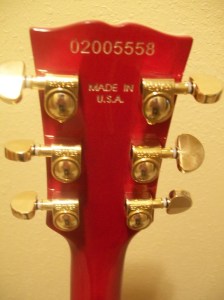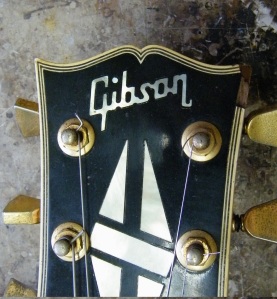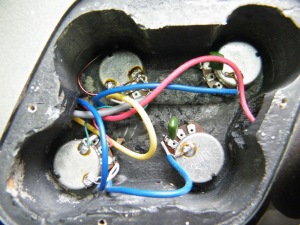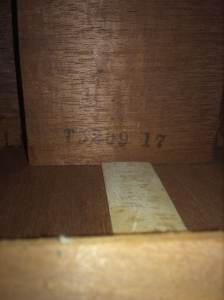(The following article appears in the latest issue of Collectible Guitar | Then and Now magazine.)
By Gabriel J. Hernandez
Let’s face it; as much as we all want to be experts in all things “guitar,” the majority of us don’t really qualify. Don’t get me wrong … we all probably fall under the category of a well-versed “guitar enthusiast.” And for those that play guitar for a living … well, you’re an entirely different animal.
Nevertheless, many try very hard and their efforts are certainly commendable. But there’s a lot of knowledge out there to digest regarding all the different guitars, and if you’re not careful you can easily end up with a guitar that looks, smells and plays like the real thing, when in fact it’s not. Every day more and more non-assuming consumers (and dealers, too) are falling victims to the many counterfeits that have flooded the market these last few years.
The main reason? Many countries (like China) don’t recognize and/or enforce the trademark laws of the United States and allow these products to be manufactured and sold freely over the Internet. So while companies and law enforcement authorities in the United States work diligently with these countries to stop the flow of counterfeit instruments into the U.S., their efforts are almost fruitless because of the lack of urgency on the part of the countries that allow this to happen in the first place. In China, for example, the country’s trademark laws are on a “first come, first served” system, and many of the guitar manufacturers failed to trademark their brand in China before someone else inside the country trademarked the same name and brand. The result? Today’s counterfeit guitar market is more prevalent than ever before, and more of them are showing up in the hands of both unassuming consumers, as well as people with not-so-nice intentions.
Take the recent arrest this past March of Wade Massey by the Murfreesboro, Tenn., police department for allegedly selling counterfeit Gibson guitars to seven different pawn shops in and around the Nashville area. His case is still pending, but according to police reports Massey allegedly sold or pawned guitars he assumed were authentic Gibson instruments worth thousands of dollars. Massey told police he didn’t know they were fakes, and the pawn shops thought they were real until one of them took a guitar to be appraised, only to find out it wasn’t real.
On a much larger scale, U.S. Customs and Border Protection agents this past April seized nearly 200 counterfeit guitars worth more than $1 million at a mail facility in New Jersey. In that case, the load of counterfeits included Gibsons, as well as other brands like Fender, Martin, Taylor, Paul Reed Smith, Ernie Ball and Epiphone. Authorities reported finding business cards inside each package with the name of a website that offered the guitars from China for $200-to-$500 each. The agency reported that authentic guitars just like the ones seized have suggested retail prices ranging from $2,000 to as much as $54,000. Every guitar seized was also allegedly stamped “Made in U.S.A.”
Personally, I’ve been playing guitar since the age of six. I’m now 51, and have been buying and selling guitars for the better part of the last 15 years – six of those as a bona fide business that feeds my family. And just when I think I know everything there is to know about spotting fake guitars, along comes another one (not necessarily fake) that offers me yet another valuable lesson in figuring out what’s real and what’s not.
Anyone that wants to build a personal guitar collection, or simply own a few different models for different styles of music, should know how to tell an authentic from a fake. And if you’re just getting into vintage guitars you may also consider learning how to spot guitars that have been altered, because the ones that have been altered usually have been to hopefully increase their value in the “eyes” of the buyer … because in the “eyes” of the market, any altered vintage guitar in most cases is worth less money than one that isn’t.
So, let’s start with the popular Gibson Les Paul Standard. Pick any year from 1954 thru today, and I guarantee you there’s a fake Gibson Les Paul out there from that year. Some are poorly made and easy to spot. But some of these overseas companies are getting pretty good at replicating the characteristics of an authentic Gibson Les Paul.
Here are a few tips that should help you figure out if you’re looking at a fake or authentic Gibson Les Paul Standard:
- Look at the serial number. For the most part, every Gibson guitar made prior to 1953 has a serial number or “factory-order number” (FON) located on either the neck block (inside the guitar), or a label (also inside the guitar). From 1953 to today, most Gibson solidbody guitars have the serial number either “inked” (1953 to 1961) or stamped into the back of the headstock (1961 to today). The serial numbers on fake Gibsons almost NEVER match the font of the serial number of a real Gibson guitar, though some have come close in recent years. On stamped Gibson headstocks, the company has for years used the same stamping machine, so if you’re looking at a stamped serial number you should be able to tell pretty quickly. Additionally, if you have any doubts simply call the Gibson Customer Service Department and give them the serial number. They can instantly check any serial number after 1993, and if you send them a picture via email they are very good at getting back to you with their findings.
- Look at the shape of the headstock and the Gibson logo on the headstock. A fake Les Paul headstock has a more severe, less sweeping flow, and a deeper notch. Also, the logo on a fake Les Paul is usually not Mother of Pearl with a rather “plastic” quality to it, and most look rather “bloated.”
- A real Gibson Les Paul has a low profile Corian nut with very shallow slots that allow the player to adjust to taste. The nut on a fake is usually made of generic, cheap, deep cut plastic. Another great way to tell a fake is to look at how the neck binding meets the nut … on a real Gibson the binding stays the same width and ends neatly at the nut. On a fake the binding is much wider at the nut, and pretty obvious. This is also a characteristic of many other name brand fakes.
- Over the years Gibson has manufactured a number of different Tune-o-Matic bridge styles. However, NEVER have they made one with large bore slotted head screws on each end. They all sit on top of a pole piece that can be adjusted up or down by simply turning it in the direction desired. The top of that pole piece is smooth, with no slot for a screwdriver of any type. Additionally, the saddles are not as low-profile.
- The binding on all Gibson Les Pauls have very crisp clean lines, especially the multi-layered bindings found on Gibson Les Paul Customs. The bindings on most fakes are almost always wavy and usually look very sloppy. Additionally, the fingerboard binding on any Les Paul prior to 2014 goes over the ends of each fret (Gibson changed this feature in mid-2014). On a fake, the fret wire is usually very poorly installed, and usually goes all the way over the side of the fingerboard and over the binding. A simple test is to run your fingers up and down each side of the fingerboard … if it’s a fake you’ll probably cut your finger on the end of the frets. This is the the second best way to spot a fake Les Paul (serial numbers being the first).
And two more things to note: First, authentic Gibson Les Pauls have two screws holding the truss rod cover onto the peghead, while many fakes have three. If you find one with two screws and you’re still not sure, remove the truss rod cover and look at the truss rod adjuster. On a real Les Paul it should be a brass nut that requires a small socket to make an adjustment (Gibson usually provides this tool), while a fake will have a much deeper cavity with an adjuster that needs an Allen wrench or Hex key to make the adjustment. Second, if you turn the guitar around the electronics cavity on a fake Les Paul is usually not the correct shape of one found on a real Les Paul, and the potentiometers and capacitors are the small ones made in China. Also, the wiring coming from the pickups usually has colored insulation on the fakes, whereas a real Les Paul has braided insulated wiring and expensive pots and capacitors.
Here are some notes that should help you spot other major name brand fakes:
Fender: Stratocasters typically feature vintage Kluson-style or American-series tuners, while fake Fender guitar tuners are usually cheap looking chrome. The bridge on a real Fender Stratocaster is brushed stainless steel. Also, fake Fender Strats will often have wider-than-normal spacing between the dot inlays on the 12th fret. Somewhat conversely, the screw spacing on an authentic Strat tremolo cover is somewhat scattered, so if the six screws are lined up with each other you’re probably looking at a knock-off Strat.
Martin: If the guitar is brand new, a Martin fake can be the hardest to spot. However, Martin is in the process of implementing some pretty forward-thinking technology: they’re making plans to use DNA to ensure that customers are getting the real deal when purchasing a Martin guitar. After a wave of Chinese-made fakes hit the market earlier this year, the company employed New York-based Applied DNA Sciences to “tag” each genuine instrument with a DNA signature. Eventually, the company plans to use real plant DNA with a particular sequence as a tag of authenticity. The DNA can be infused at any point of the guitar manufacturing, from the lacquer finish to the ink in the “C.F. Martin Guitar Co.” engraving. In the meantime, however, the flaws of any counterfeit Martin is still the easiest way to spot a fake. While the designs are stolen directly from Martin’s finest guitars, the materials used to build them are not. These fakes can sound and feel great for a very short time, but they will almost immediately begin to fall apart, i.e., develop cracks, seam separations, or they can also sport uneven rosettes and headstock shapes, and variances on the backstripe. Another common feature on a fake Martin is the appearance of a paper label inside the guitar, which is something Martin rarely uses (it does occasionally, but only on rare limited edition models).
To end on a positive note, here’s the story of a 1958 Gibson Country Western that recently came into my office. The acoustic was in immaculate shape, with no lacquer checking, cracks, breaks, etc. It was, as they say, “too good to be true.” Being the ever pessimist that I am, I automatically began to discount it as a probable fake, or one that had had some significant work done to it. To make matters worse, as soon as I looked at the back of the headstock I was nearly convinced it was fake because the factory-order number – or FON – was also stamped on the back of the headstock, and in a much larger font than usual for Gibson. I had never seen this before.
Before I sent the guy on this way with this supposed “fake”, however, my gut told me to call someone for a second opinion, so I did. First, I called the Gibson Customer Service Department, but they didn’t give me a clear explanation as to why it might have the FON on the back of the headstock and wanted me to send in pictures via email, which I didn’t have time to do. So I made a second call, this one to my good friend and former long-time Gibson banjo and mandolin maker Scott Holyfield, who is now employed by Nashville’s best luthier, Joe Glaser. I asked Scott about the FON being on the back the headstock and he immediately knew why it was there. He told that the guitar had most likely gone back to Gibson at some point during the early to mid-1960s for some repair work, probably a neck reset or new truss rod installation. When Gibson removed the neck from the body, they stamped the back of the headstock with the guitar’s FON (the same one on the neckblock inside the guitar) so they would know that that particular neck belonged to that particular body. I had never seen this before, and Scott told me he hadn’t seen that many either, but that he had seen “a few here and there.” The explanation was good enough for me, and I eventually ended up buying one very sweet 1958 Gibson Country Western in NEAR MINT condition!
The moral of the story is “DO YOUR HOMEWORK!” If you’re not sure, ask questions, do some research, use Google or any other search engine. In today’s computerized society there are literally millions of sources at your fingertipsl to make sure you’re buying the real deal. Use them all, or you could end up spending thousands of dollars for something worth only a few hundred … or worse, nothing at all.
You could also end up like me … with a beautiful 1958 Gibson Country Western acoustic that’s so nice it may never see the inside of my showroom! (I hope my wife doesn’t read this.)
Gabriel J. Hernandez is the owner of Blues Vintage Guitars, Inc., a shop in Nashville, Tennessee, specializing in the buying and selling of vintage and newer high-end guitars and gear. He is also an accomplished writer, having earned a B.S. in Journalism from The University of Florida in 1988. Over a 25-year career he has worked as an investigative journalist for several news organizations and publishing companies, as a staff sports writer for The Palm Beach Post, and most recently as the Web Editor for Gibson Guitars at the company’s worldwide headquarters in Nashville. Hernandez has played guitar since the age of six, and been fascinated (some say obsessed) by the instrument – and music in general – ever since. You can reach him any time at 1-615-613-1389, or visit his company’s web site at www.bluesvintageguitars.com, or Facebook page at www.facebook.com/bluesvintageguitars.













Last year I bought a GIBSON LES PAUL that had a mirrored front I called gibson and they said via the serial # it was a standard.The seller claims it was a promo given to a band. “BETTY” They were sucessful in the 1990-2005..I paid $600.00 for it.I will bring it to my local guitar store and see what they say.I just bought A 2014 SEA FOAM GREEN LES PAUL. I have not got it yet.I usally buy via ebay .I have about 50 guitars. Oh my what have I got my self into..dano
let’s hope the Chinese counterfeiters aren’t reading this…
Incredible and useful read!!! I’ve always felt good about all of my LP purchases, but didn’t know how close the fakes are getting. I hope this article get circulated widely enough to make all buyers savvy.
Thanks for your kind words. I definitely appreciate them! Feel free to copy and paste the link to the article anywhere you wish. All I ask is that you always mention where it came from and who wrote it. Thanks again!